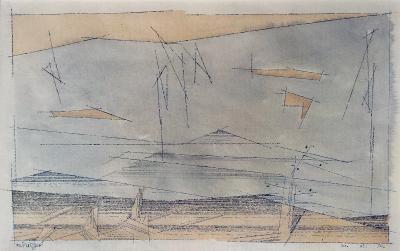Lyonel Feininger
American, 1871 - 1956
Lyonel Feininger was born in New York, the son of concert musicians.
In 1887 he went to Germany to refine his skills as a violinist but decided to study painting instead, attending the Kunstgewerbeschule in Hamburg, the Berlin Academy, and the Academie Colarossi in Paris. From 1893 to 1907 he spent most of his time working as an illustrator for German and American periodicals, an activity that influenced the decorative, two-dimensional style of his early work.
He lived in Paris from 1906 to 1908, during which time he met the progressive painters Robert Delaunay and Jules Pascin and looked closely at their work, as well as at that of Paul Cezanne and Vincent van Gogh. He also began painting full-time, incorporating vanguard aesthetics into his work.
He developed a Iyrical style based on Cubist fragmentation and Expressionist distortion and a concern for the emotive qualities of light and color. He exhibited with Der Blaue Reiter group in 1913. Six years later, at the invitation of the architect Walter Gropius, he was appointed to the faculty of the Bauhaus as Master of Form in the Printing Shop, a position he retained until 1933.
In 1924 Feininger joined the Blue Four and, along with his cohorts Wassily Kandinsky, Alexej von Jawlensky, and Paul Klee, exhibited in New York, Chicago, and elsewhere. Feininger returned to United States during the mid-1930s.
Biography courtesy of Roughton Galleries, www.antiquesandfineart.com/roughton
In 1887 he went to Germany to refine his skills as a violinist but decided to study painting instead, attending the Kunstgewerbeschule in Hamburg, the Berlin Academy, and the Academie Colarossi in Paris. From 1893 to 1907 he spent most of his time working as an illustrator for German and American periodicals, an activity that influenced the decorative, two-dimensional style of his early work.
He lived in Paris from 1906 to 1908, during which time he met the progressive painters Robert Delaunay and Jules Pascin and looked closely at their work, as well as at that of Paul Cezanne and Vincent van Gogh. He also began painting full-time, incorporating vanguard aesthetics into his work.
He developed a Iyrical style based on Cubist fragmentation and Expressionist distortion and a concern for the emotive qualities of light and color. He exhibited with Der Blaue Reiter group in 1913. Six years later, at the invitation of the architect Walter Gropius, he was appointed to the faculty of the Bauhaus as Master of Form in the Printing Shop, a position he retained until 1933.
In 1924 Feininger joined the Blue Four and, along with his cohorts Wassily Kandinsky, Alexej von Jawlensky, and Paul Klee, exhibited in New York, Chicago, and elsewhere. Feininger returned to United States during the mid-1930s.
Biography courtesy of Roughton Galleries, www.antiquesandfineart.com/roughton
Lyonel Feininger was born in 1871. He traveled to Hamburg, Germany in 1887, originally to study music but quickly turned to art, studying at the Berlin Academy. Feininger was a Cubist painter who depicted modern life and architecture such as cathedrals, factories and harbors. He infused his subjects with emotional color, which was meant to be evocative. Feininger worked as an illustrator, cartoonist and also crated children's books. In 1919, Feininger was invited to join the faculty of the Bauhaus, where he taught until Hitler shut it down in 1933. A few of his paintings were confiscated by the Nazis and shown at the "Degenerate Art Show" in Munich, 1937. Feininger was part of "The Blue Four", along with Kandinsky, Klee and Von Jawensky. His work added dimensions in space though the use of light. Feininger successfully fused Cubism with Expressionism. He died in 1956.
Biography courtesy of The Caldwell Gallery, www.antiquesandfineart.com/caldwell
Biography courtesy of The Caldwell Gallery, www.antiquesandfineart.com/caldwell
